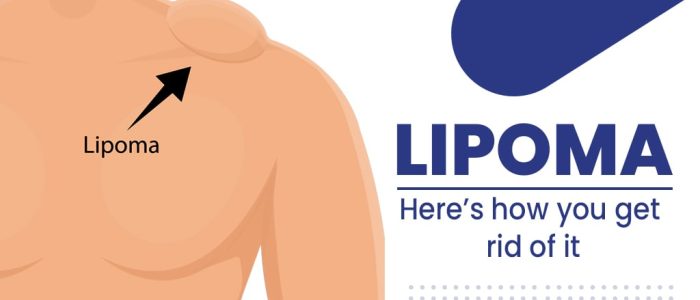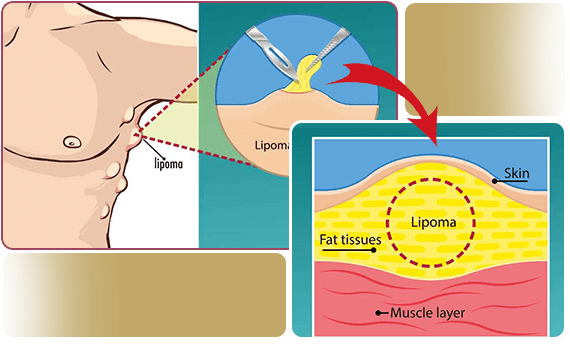What is Lipoma?
A lipoma is a typical clump of fatty tissue that typically develops just below the skin’s surface. There are other places on the body where lipomas can develop. Adults are more likely to develop lipomas than any other benign tumor, typically in the shoulders, neck, back, belly, arms, or thighs. Children can also develop lipomas.
Lipomas come in a variety of distinct subtypes. The most common type of lipoma, a conventional lipoma, consists of fully formed white fat cells; a fibro lipoma, both fatty and fibrous tissue; and an angiolipoma, both fatty tissue and blood vessels.
Most lipomas are enclosed in a thin, fibrous capsule that enlarges along with the lipoma. This prevents the surrounding tissues from being “invaded” by the lipoma. This explains why most fatty lumps are spherical, oval, and symmetrical.

How is a lipoma identified?
Most of the time, lipomas grow over a long period, which could be months or even years. Once they have reached a stable state, they almost always stay the same as time goes on. Most lipomas are smaller than 2 inches, but some can get as big as 6 inches in diameter.
Most lipomas aren’t painful or uncomfortable, but more giant lipomas, especially those that start to press on nearby nerves, can become painful. Lipomas with many blood vessels tend to hurt more than those with fewer blood vessels.
On the other hand, a typical cancerous tumor is big, solid, and hard to move. It also overgrows; many grow so fast that they seem to have “just appeared.”
Who needs surgery to get rid of a lipoma?
Most lipomas don’t need to be taken out. If your lipoma is getting bigger, hurting you, or making you feel bad about your appearance, our doctor may suggest surgery.

Lipoma surgical procedure:
Most of the time, the only way to completely get rid of a lipoma is to cut it out. Excision is the process of having a lipoma cut out by a doctor. Most of the time, it’s done in a doctor’s office or surgery center.
Your doctor will tell you exactly what to do to prepare for your procedure. They might say:
- Before the procedure, wash the area with soap that kills germs.
- Don’t shave close to the lipoma.
- On the day of your procedure, don’t take blood thinners or ACE inhibitors.
- Don’t take any other medicines in the days before your procedure.
Most people only get a small dose of anesthesia. Local anesthesia is when a surgeon puts numbing medicine into the area around the lump. An IV may give you sedation or general anesthesia if the lump is massive.
Sedatives help you feel calmer, and general anesthesia makes you fall asleep.
Recovery Process:
After your surgery, you’ll be able to go home the same day. Depending on the type of stitches your doctor uses, they will either fall off on their own after 5 to 7 days or need to be taken out.
The area where the surgery was done will likely hurt for a few days. Most of the time, over-the-counter painkillers like ibuprofen or acetaminophen can help (Advil or Tylenol).
There may be swelling. Putting ice on your bandages can help you deal with it.
Most of your daily activities will be acceptable to do right away, but your surgeon may tell you to wait a couple of days before exercising and about a week before doing vigorous sports.
What risk is involved in lipoma surgery?
Most of the time, surgery for a lipoma is safe, but every surgery has some risks. You might start to bleed or get an infection. It’s important to talk to your doctor if your stitches come out or if you get signs of a disease, like:
- Feverish or shivering.
- Itching, swelling, and pus.
- Illness or vomiting.
- Skin that’s itchy or swollen.
- After the procedure, you may have a permanent scar.
Are you thinking of getting a lipoma removal treatment in Tirupati? Have any queries about the treatment?
The well-established skin specialist in Tirupati, Dr. Prakash Sajja and his technical team are here to solve all your queries.
♥ Do call 9440830455 or Fill out our Appointment form to get in touch!
♥ Follow our Social Media pages for recent updates. Facebook | Instagram



